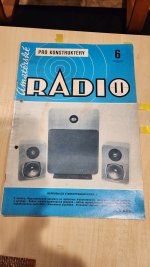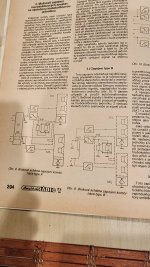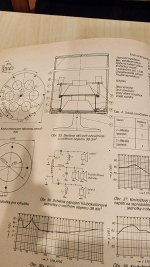Another possible issue of the Isobaric version here is that the Tweeter is 8R nominal, High-Midrange is 6R nominal, Low-Midrange is 8R nominal and the assembly of 2x Woofer is 4R nominal... This may impair the efficiency balance between the speakers ? 🤔
T
T
Last edited:
You couldshrink the chamnber a bit more, smaller the better, the triangle is a nice touch.
Yes, certainly @planet10 : for this, I need to trace the project at 1:1 scale to determine exactly the minimum required chamber. 😉
The slanted internal woofer panel doesn't go in that sense, of course, but I guess it can be nontheless a benefice for reducing internal reflections, plus I think that it clears the back of the woofer better from the back panel.
T
Last edited:
Not very scientific comment from me if it helps, my good friend has very nicely restored Linn Isobarik along with other vintage Naim-Linn stuff, and I listen to it often, well this makes what it's supposed to do, lovely music. Cabinets are not small.
Well I have eight 8" Cat Berlin and six 10" Pearl River woofers that cry out to be used. I don't have room for big cab so off-the-shelf steel trash cans or umbrella stands come into play -- typically 17L though my biggest are 27L for 10" and 42L for 12". So can I just clamshell a pair over the steel can and do better than single driver? Thanks.Better turn one woofer and use clamshell (face to face) like arrangement. It reduces distortion too.
Cut the thick (to allow xmax) circular baffle from wood, attach woofers from each side as clamshell. Remember to switch polarity to one speaker. Attach this to bottom of umbrella holder or trashcan, make hole there. Thin wall of umbrela holder or trashcan will not do, since there needs to be enough room for membrane to travel with some spare. Turn upside down, and you are done. Bottom cover is extra cherry on the cake.
I have an old magazine i followed back in socialist czechoslovakia, there were big plastic tubes like water pipes used.
It was cca 1986. I believe. I made dual isobaric subwoofer from concrete. Square box. Four 10" woofers, two on each side. Sub was heavy and it takes two people to move it. Its still functional and its still there in the room where i grew up as kid. I use it when i visit relatives.
I have an old magazine i followed back in socialist czechoslovakia, there were big plastic tubes like water pipes used.
It was cca 1986. I believe. I made dual isobaric subwoofer from concrete. Square box. Four 10" woofers, two on each side. Sub was heavy and it takes two people to move it. Its still functional and its still there in the room where i grew up as kid. I use it when i visit relatives.
Example of the magazine we had that time...first it explains all the theory, then there are construction details for many options. This magazine issue is about satelite/sub approach and about isobaric subs.
Attachments
Agreed.Then i expect winISD is wrong.
I designed an isobaric speaker last year for the InDIYana theme competition. During all the research that I did, I am pretty sure WinISD IS WRONG. But it didn't matter in my case in any practical way, they're just inefficient speakers... And that is okay (for me).
Would you care to show something to back that up?During all the research that I did, I am pretty sure WinISD IS WRONG
lovely music. Cabinets are not small.
They aren’t that big. It has been some 45 years since i heard a tri-amped Linn Isobarik system… in a biggish room. It was very musical & enjoyable. I have evolved since then i might be a bity more picky now.
dave
This makes sense, but if it was that simple, why would WinISD not calculate it correctly?As far as I'm aware (& ignoring external effects) assuming parallel wiring, then 1m/1w efficiency on an isobaric is essentially -3dB relative to a single unit, while 1m/2.83v sensitivity is unchanged relative to one unit.
Sure, see Scottmoose's post #29.Would you care to show something to back that up?
Basically I researched and found lots of posts, some conflicting. But in general WinISD did not match what most of those posted were saying.
Since I didn't care whether the speakers were less sensitive, less efficient, the same as a single, etc. I just ignored that aspect in WinISD and didn't pursue any further. But I can tell you I need to turn the volume knob up on my isobaric speakers relative to all of my non-isobaric speakers.
For the two combinations having the same external cabinet size :
* The Isobaric offers a better step response and better group delay vs. the non-Isobaric single woofer.
* We can also expect a slightly extended very low end extension for the Isobaric, but with an earlier frequency drop start at 100Hz vs. 70Hz for the non-Isobaric single woofer.
Without real surprise, this is due to the QTC=0.70 of the Isobaric instead of the QTC=0.81 for the non-isobaric single woofer.
While true, having the single driver in essential a box half the size explains it all.
dave
WinISD is not right about isobaric. Bothered me just lately.
Isobaric usually makes sense with 8 Ohm chassis. In parallel with halved impedance most amps deliver more power, so lost efficiency doesn't matter that much in practice.
If you want the numbers for a simulation, two identical chassis in iso configuration just have half the Vas.
In practice, just for those that want to stay 100% correct, Fs should be a little lower, because the mass of the air in the coupling chamber adds to Mms. I don't think this is of practical importance.
It is a nice principle to use up left over (PA) chassis for Hifi. Today the extra power needed is usually no problem.
PS can be used in closed and vented constructions, just like in any other idea you could have. Just 1/2 the Vas
Isobaric usually makes sense with 8 Ohm chassis. In parallel with halved impedance most amps deliver more power, so lost efficiency doesn't matter that much in practice.
If you want the numbers for a simulation, two identical chassis in iso configuration just have half the Vas.
In practice, just for those that want to stay 100% correct, Fs should be a little lower, because the mass of the air in the coupling chamber adds to Mms. I don't think this is of practical importance.
It is a nice principle to use up left over (PA) chassis for Hifi. Today the extra power needed is usually no problem.
PS can be used in closed and vented constructions, just like in any other idea you could have. Just 1/2 the Vas
I'm using the latest. It's not like it receives monthly updates 🙂
Not the point.IIRC something like V0.54
NOTE! WinISD is still in betaversion, so please be patient with errors that may occur.
dave
One more thing that can make isobaric interesting: One voice coil may not be able to stand the power needed to DSP the speaker in a small volume. Two speaker double the driving force and therefore can take twice the electrical power.
It all boils down to a problem solver, when using chassis not matching the needed parameter for a given construction. I don't think one would build isobaric if he is free to choose the chassis.
You often run into such problems when you buy chassis with incorrect data, something very common. Always look at the date the advertised TSP where recorded. You often find 20 years and older measuring sheets used in actual offers, mostly from the cheap side of the market. Don't expect these to be (still) real.
Such occasions are the ones you usually can not return...
It all boils down to a problem solver, when using chassis not matching the needed parameter for a given construction. I don't think one would build isobaric if he is free to choose the chassis.
You often run into such problems when you buy chassis with incorrect data, something very common. Always look at the date the advertised TSP where recorded. You often find 20 years and older measuring sheets used in actual offers, mostly from the cheap side of the market. Don't expect these to be (still) real.
Such occasions are the ones you usually can not return...
The bug in WinISD is the impedance of the chassis not being corrected. If you edit the driver in the actual ISO calculation (this only changes the values in this single simulation, not in the database!) and divide Re by 2 you get correct results.
Of course this is for both voice coils in parallel. In reality this may be to low for some amps, so using two amps would be the best option for 4 Ohm chassis.
Of course this is for both voice coils in parallel. In reality this may be to low for some amps, so using two amps would be the best option for 4 Ohm chassis.
Scale 1:1 drawing, here with vertical back speaker panel, in order to minimize the chamber :

I think I have been too far in reducing the chamber volume : the magnet of the front speaker closes too much the cone of the back speaker... IMHO, this is not a very good idea : it could possibly have notable effects on the dynamic coupling of the two speakers... 😕

I think that I will return to a slanted disposition, with a bit less minimalistic chamber, in order to free more the cone of the back speaker, to avoid facing too directly the magnet of the front speaker. 😉
T
I think I have been too far in reducing the chamber volume : the magnet of the front speaker closes too much the cone of the back speaker... IMHO, this is not a very good idea : it could possibly have notable effects on the dynamic coupling of the two speakers... 😕
I think that I will return to a slanted disposition, with a bit less minimalistic chamber, in order to free more the cone of the back speaker, to avoid facing too directly the magnet of the front speaker. 😉
T
- Home
- Loudspeakers
- Multi-Way
- ISOBARIC sealed enclosure... Any experiences? Any advantages?



